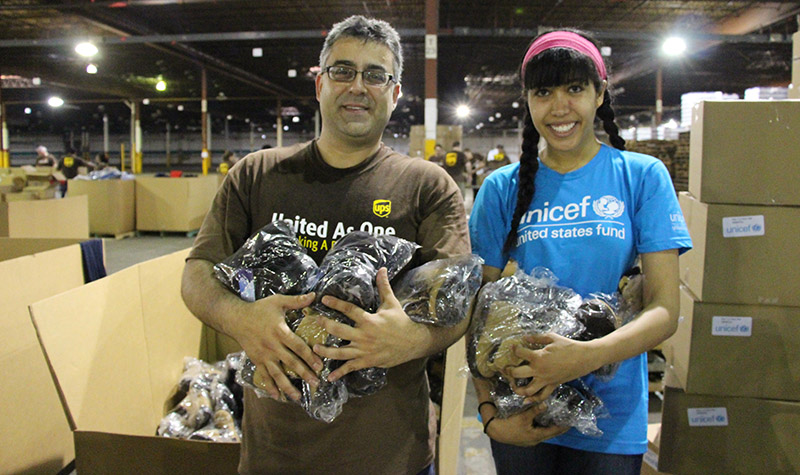Disaster Philanthropy Playbook

Spotlight on the UPS Foundation
The UPS Foundation and the company not only provide financial support but also, through the Foundation’s Humanitarian Relief and Resilience program, provide support across a broad range of humanitarian crises. This includes emergency preparedness, disaster response and post-crisis recovery through a full array of assistance. This often includes large grants, transportation support, inventory tracking software, and technical experts who advise the foundation’s strategic partners regarding the distribution of food, medical supplies, and other necessary goods as efficiently and rapidly as possible.
UPS works with approximately 20 partner organizations around the world including the American Red Cross, CARE, The Salvation Army, UNICEF, UNHCR and World Food Programme as well as smaller local organizations.
UPSers share their unique logistics capabilities through a skilled volunteer program called the Logistics Emergency Team (LET). These teams provide post-disaster warehouse management support, transportation services, air ramp assistance, and customs clearance services, just to name a few. Over 70-plus UPS volunteers have been trained and are ready to deploy to a disaster area within 72 hours and stay onsite for three to six weeks. The idea behind such a highly skilled team of volunteers is to get life-sustaining supplies to disaster areas within days rather than weeks or months.
In partnership with UNHCR, UPS and its foundation launched the UPS Relief Link program earlier this year. The overall goal of the program is to improve humanitarian supply chain logistics. Relief Link combines the use of handheld scanning devices and identification cards to improve the distribution and tracking of critical supplies, as well as minimize theft. Relief Link allows for the tracking of supplies to their final destinations and provides up-to-date information regarding the items most urgently needed by people in remote areas.
Working on technologies like Relief Link makes it easier for aid workers to keep on top of the supplies they have and what’s still needed, and helps to ensure that those supplies are adequately distributed.
Joe Ruiz oversees the Foundation’s Humanitarian Relief & Resilience Program, and emphasizes preparedness, technology, and coordinating local assistance, as pillars to success. UPS teams utilize local people, local knowledge, and local assets.
For example:
- Joe’s team trained UPS logistics officers to be frontline responders in disasters and then placed them in American Red Cross units working in the U.S. Gulf region following Hurricane Katrina and most recently following severe flooding in South Carolina.
- Logistics Action Teams were established to work with local American Red Cross chapters. Ten teams were placed along the Gulf Coast to work with individual ARC chapters, coordinate transportation and delivery of supplies, helping ARC achieve improved efficiency rates.
- UPS and Toyota worked with New Orleans’ based St. Bernard Project, using Toyota’s productivity model which helped reduce the time to build a home, thereby speeding the return of families affected by Hurricane Katrina..
- Following the 2011 Joplin MO tornado, this model got disaster victims back in their homes within 3.5 years (typical recovery time 5-7 years) Hurricane Sandy – Logistical Action Teams (LATs) provided two drivers per day to transport supplies and assist with recovery efforts.
- Over 70 UPS employees are trained and deployed worldwide (experts in transportation, warehouse management, customs clearance and airport operations). UPS employee-facilitated teams have been deployed to 12-plus disasters since 2008.
The Humanitarian Relief & Resilience Program also supports public-private partnerships that promote preparedness in the U.S. and abroad, including the Resilient America Program led by FEMA and the National Academies of Science and the Saglam Kobi business disaster resilience initiative in Turkey to better prepare small and medium businesses for disaster risks.
UPS also provides support for innovations like the Good360 DisasterRecovery360 donations management system that allows corporate and individual donors to respond to the specific needs of relief agencies and communities recovering from crises.
The Disaster Resilience and Recovery Program includes guidelines and procedures, and these ideas and plans are shared with national and local agencies during other disasters.
In keeping with this open policy, the UPS Foundation gathers with its strategic partners at the beginning of every year to discuss their emergency funds and in-kind budgets. When a disaster strikes, the partners are able to choose whether they want to pull resources from their in-kind budgets or their emergency funds. These flexible and available budgets are just one of the reasons UPS is able to respond so quickly in disaster aftermath.
The UPS Foundation’s model program provides a $10 million annual investment for community safety, logistical expertise, skilled volunteers, and capacity building efforts to UPS partner agencies. This model philanthropic effort enhances community resilience and strengthens preparedness, response and recovery capabilities of local nonprofit organizations.